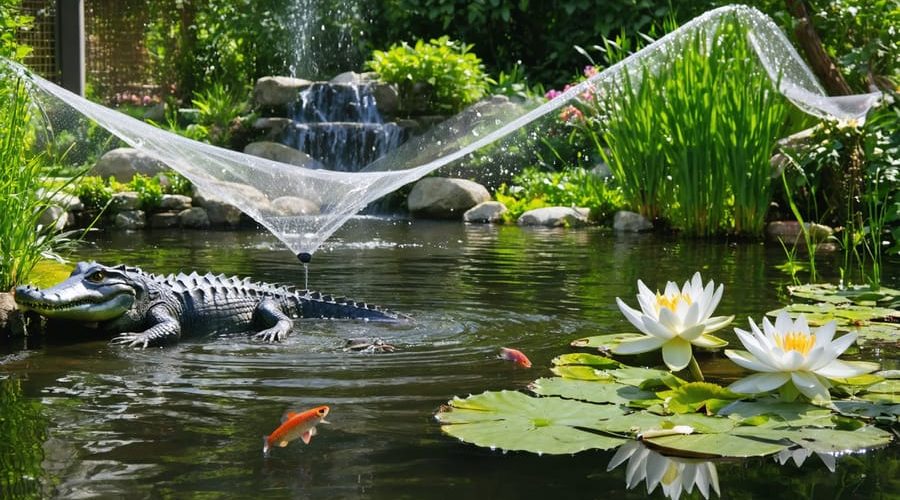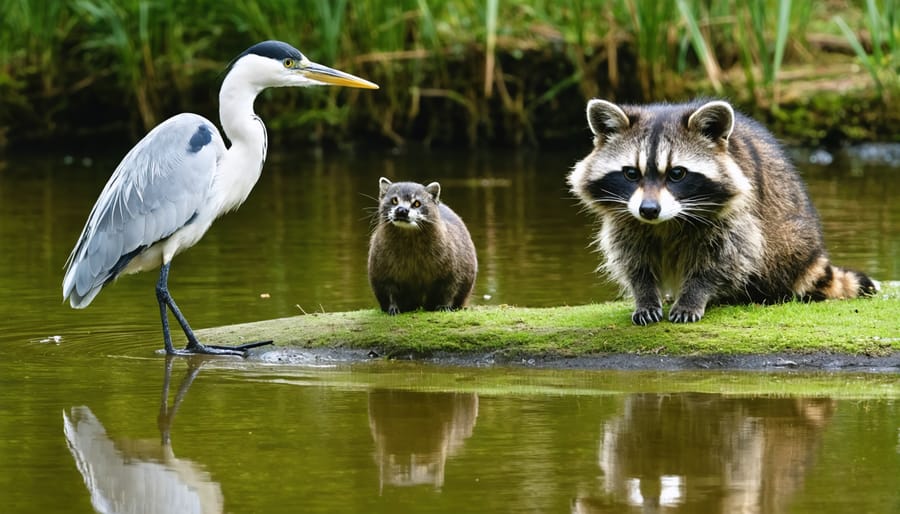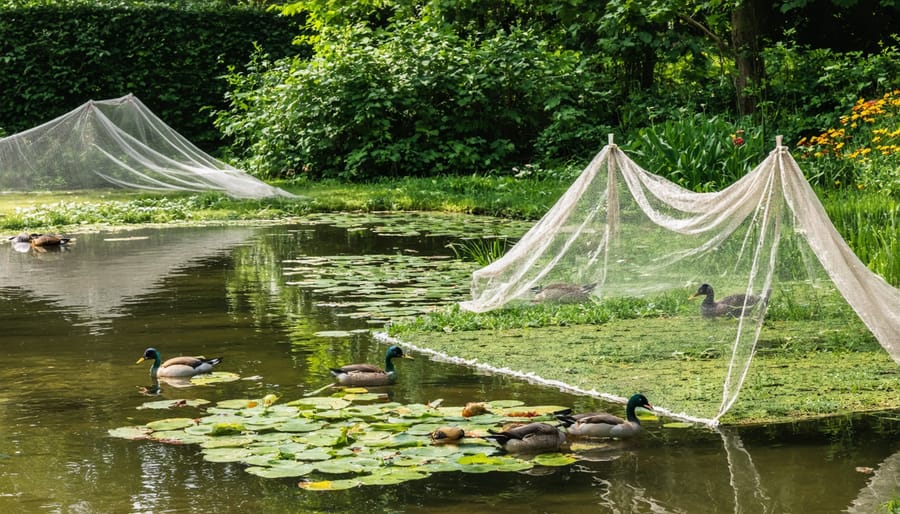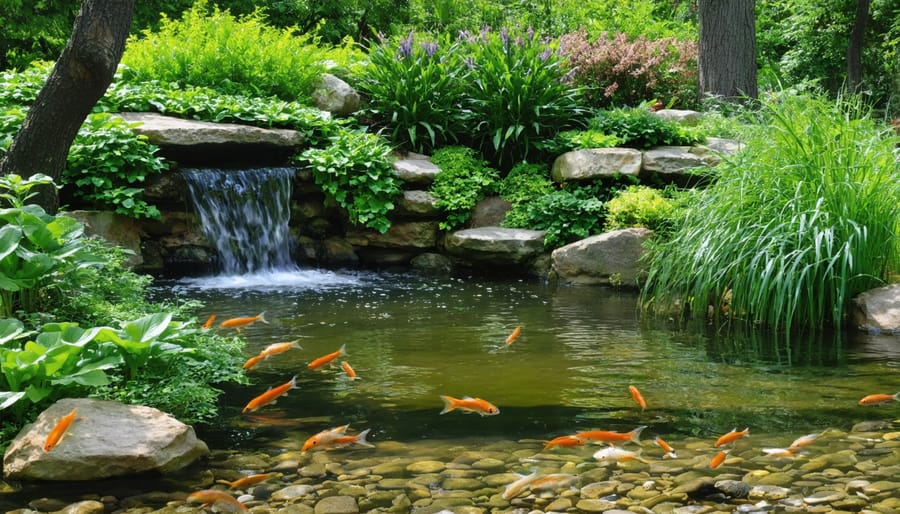
Keep Predators Away From Your Pond Without Harming Local Wildlife
Protect your pond’s precious inhabitants while helping to maintain ecological balance in your local ecosystem. Modern non-lethal defense strategies offer humane solutions that keep predators at bay without causing harm. Motion-activated sprinklers startle herons and raccoons, creating an effective deterrent zone around your water garden. Strategic placement of netting and floating covers provides physical protection while preserving your pond’s natural beauty. Pond depth zones of 24 inches or deeper offer fish crucial escape routes from hunting birds, while carefully positioned decoy predators create a natural deterrent that blends seamlessly with your landscape. These proven methods work together to create a protective environment that respects both your aquatic pets and local wildlife, ensuring your pond remains a thriving sanctuary for all its inhabitants.

Common Pond Predators You Need to Watch For
Birds: Herons, Kingfishers, and Cormorants
These graceful but persistent predators are common visitors to backyard ponds. Herons, particularly the grey heron, are tall wading birds that can stand motionless for long periods before striking at fish. They’re most active during dawn and dusk, and tend to return to successful hunting spots regularly.
Kingfishers are smaller but equally skilled hunters, recognized by their distinctive bright blue and orange coloring. They typically perch on nearby branches or posts before diving quickly to catch fish. Unlike herons, they’re more likely to visit throughout the day.
Cormorants are less common in backyard settings but can be problematic for larger ponds. These diving birds can swim underwater to chase fish, making them particularly efficient predators. They’re typically dark-colored and often seen spreading their wings to dry after swimming.
Understanding these birds’ behavior patterns is crucial for effective deterrence. They’re creatures of habit, so breaking their routine with varying deterrent methods can be particularly effective. Remember that these birds are protected in many regions, making non-lethal deterrence not just preferable, but legally necessary.
Land-Based Threats: Raccoons, Cats, and Other Mammals
Mammalian predators pose a significant threat to pond life, with raccoons being particularly notorious for their fishing skills. These clever creatures are excellent swimmers and can easily wade into shallow waters to catch fish. They typically hunt at night, using their sensitive paws to feel for movement beneath the surface.
Domestic and feral cats are another common concern, as they’re naturally drawn to water movement and can spend hours perched near ponds, waiting to swipe at fish that venture too close to the surface. While they generally don’t swim, their quick reflexes make them effective hunters of smaller fish and pond inhabitants.
Other mammals like minks, otters, and foxes may also target your pond, especially in rural areas. These predators are opportunistic hunters and will return regularly once they discover your pond as a food source. Minks are particularly problematic as they’re excellent swimmers and can pursue fish underwater.
Understanding these predators’ hunting patterns is crucial for implementing effective deterrents. Most are nocturnal and rely on stealth, so focusing protection efforts on nighttime security and creating physical barriers around your pond’s perimeter will yield the best results.
Physical Barriers That Actually Work

Netting and Covers
Protective netting and covers serve as excellent physical barriers against predators while maintaining the visual appeal of your pond. Fine mesh netting, typically with openings of 1/2 inch or smaller, effectively prevents herons and other large birds from accessing your fish while allowing smaller beneficial insects to pass through.
For optimal protection, install netting at least 12 inches above the water surface, creating a dome-like structure. This prevents predators from pushing the netting into the water and reaching the fish. Secure the edges firmly using landscape stakes or heavy rocks, ensuring there are no gaps where wildlife could enter.
Rigid pond covers, such as metal grids or plastic lattices, offer a more permanent solution. These covers can support more weight and withstand harsh weather conditions better than netting. Consider installing access panels in rigid covers for easy maintenance and feeding.
For seasonal protection, floating covers work well during vulnerable periods. These covers rest directly on the water surface and move with water fluctuations. They’re particularly useful during spawning seasons when fish are more visible to predators.
Remember to regularly inspect and maintain your protective barriers. Remove debris, repair any damage, and adjust tension as needed. During winter, ensure your covers can support potential snow load, and create ventilation spaces to prevent harmful gas buildup under ice.
Floating Deterrents
Floating deterrents offer an effective and visually interesting way to protect your pond while maintaining its aesthetic appeal. These surface-level solutions work by creating movement and unexpected obstacles that make predators think twice before approaching your pond.
Popular floating options include decoy alligators and crocodiles, which can startle potential predators and discourage them from entering the water. While they might look a bit quirky, these realistic replicas have proven quite effective, especially against birds and small mammals.
Motion-activated floating sprayers add another layer of protection. When triggered by movement, these devices spray a quick burst of water, startling approaching predators without causing harm. The unexpected spray teaches wildlife to avoid the area, and the constant movement of these devices on the water’s surface creates additional deterrence.
Floating lights and reflective devices are particularly useful during dawn and dusk when predators are most active. Solar-powered floating lights can create random patterns of illumination, while reflective pinwheels and spinners generate unpredictable flashes of light that confuse and deter unwanted visitors.
For the best results, try combining different types of floating deterrents and regularly changing their positions around your pond. This prevents local wildlife from becoming too familiar with their presence and maintains their effectiveness over time. Remember to secure all floating devices with appropriate anchoring to prevent them from drifting to one side of the pond.
Smart Technology Solutions
Motion-Activated Sprinklers
Motion-activated sprinklers offer an effective and humane way to deter unwanted visitors from your pond area. These smart devices combine motion sensors with targeted water sprays, creating an unexpected but harmless deterrent that startles predators without causing harm.
To set up a motion-activated sprinkler system, start by identifying key entry points where predators typically approach your pond. Position the sprinklers at these locations, ensuring they have a clear line of sight and adequate water pressure. Most units connect directly to your garden hose and can be adjusted for sensitivity, spray distance, and coverage area.
For best results, install multiple sprinklers to create overlapping zones of protection. Consider mounting them on sturdy stakes or poles at varying heights to target different types of predators. During installation, test the spray pattern to avoid accidentally soaking walkways or seating areas.
The surprise factor of sudden water spray is particularly effective against common pond predators like herons, raccoons, and cats. These animals quickly learn to avoid the area after a few encounters. For maximum effectiveness, regularly check the batteries and water connection, and adjust the sensors seasonally as vegetation growth may affect their performance.
Remember to disable the system when performing pond maintenance or when expecting visitors to avoid any unexpected showers!
Light and Sound Systems
Light and sound deterrent systems offer an effective, humane way to protect your pond without causing harm to visiting wildlife. Motion-activated lights can startle and discourage nighttime predators, making them think twice about approaching your pond. These systems work particularly well against raccoons, herons, and other nocturnal visitors who prefer to hunt under cover of darkness.
For daytime protection, ultrasonic devices emit high-frequency sounds that are unpleasant for predators but generally undetectable to humans. These sounds create an uncomfortable environment for unwanted visitors while being completely safe for your fish and plants. Some advanced systems combine both light and sound features, providing round-the-clock protection.
When setting up light systems, position them to illuminate the most vulnerable areas of your pond, particularly near shallow sections or places where predators might easily access the water. For best results, use multiple lights to eliminate dark spots where creatures might slip through undetected.
Sound deterrents should be placed strategically around your pond’s perimeter, typically elevated slightly above ground level. Remember to rotate the frequency settings occasionally, as some predators may become accustomed to a single sound pattern over time.
Both options are energy-efficient and can be solar-powered, making them practical additions to any pond protection strategy.
Natural Deterrent Methods
Protective Planting Strategies
Strategic plant placement can create natural barriers that discourage predators while enhancing your pond’s aesthetic appeal. Protective plants for ponds serve multiple purposes, offering both beauty and security for your aquatic pets.
Dense, thorny bushes like barberry or raspberry can create an uncomfortable barrier for larger predators attempting to access your pond. Plant these strategically around the perimeter, focusing on areas where predators are most likely to approach. Tall ornamental grasses like bamboo or pampas grass provide excellent coverage while maintaining a natural look.
Consider incorporating plants with different heights to create layers of protection. Low-growing ground covers can eliminate hiding spots for smaller predators, while taller plants create physical obstacles. Japanese holly and juniper bushes are excellent choices, as their prickly foliage deters animals without being overly aggressive.
For immediate pond edges, marginal plants like iris and rushes offer fish natural hiding spots while making it difficult for predators to wade in. These plants also help stabilize pond banks and contribute to water quality. Remember to maintain your protective plantings by regular pruning to prevent overgrowth while preserving their defensive qualities.
Place these natural barriers about 2-3 feet from the pond’s edge to allow for maintenance access while maintaining their protective function. This spacing also ensures that falling leaves won’t excessively accumulate in your pond water.

Safe Haven Design
Creating safe havens within your pond isn’t just about protection – it’s about giving your aquatic friends peace of mind and a place to call home. Start by incorporating plenty of submerged plants, which provide natural cover and hiding spots for fish when they feel threatened. Water lilies are particularly effective, offering shade and protection with their broad floating leaves.
Strategic rock placement is another key element in safe haven design. Create underwater caves and overhangs by carefully stacking rocks of various sizes. These structures should be stable and have multiple exit points, allowing fish to quickly escape if needed. Remember to avoid sharp edges that could harm your pond inhabitants.
Floating islands and artificial fish shelters can add another layer of protection. These can be as simple as partially submerged planting baskets or purpose-built fish refuges. Position them at different depths to accommodate various species and sizes of fish.
Don’t forget about the pond’s depth – maintaining areas at least 3-4 feet deep provides natural protection, as many predators won’t venture into deeper water. Create different depth zones, with the deepest area ideally located away from the pond’s edges where predators typically strike from.
For maximum effectiveness, combine these hiding spots with other protective measures. Place them near deterrent devices or under protective netting to create comprehensive safe zones that your pond inhabitants can easily access when feeling threatened.
Seasonal Protection Tips
Just as nature changes through the seasons, your seasonal protection strategies should adapt too. Spring brings nesting birds and increased predator activity, making it crucial to reinforce netting and maintain vigilant monitoring. Consider adding temporary floating deterrents during this active period.
Summer often sees more daytime predator visits, particularly from herons and egrets. Ensure your water features, like fountains and waterfalls, are running consistently to create movement and noise. Maintain healthy plant coverage to provide natural hiding spots for your fish, but trim back overgrowth that could serve as predator perches.
Fall requires special attention as migratory birds pass through. This is an excellent time to check and repair any damaged deterrents before winter. Consider adding extra protective measures during peak migration periods.
Winter might seem quieter, but hungry predators become bolder when food is scarce. Keep ice-free zones in your pond to prevent fish from becoming easy targets when they cluster in shallow areas. If using pond netting, ensure it’s elevated enough to prevent collapse under snow weight.
Remember to regularly inspect and maintain your deterrent systems throughout the year. What works in one season might need adjustment in another, so stay flexible and observant of changing predator patterns in your area.
Protecting your pond and its inhabitants doesn’t have to come at the expense of local wildlife. By implementing a combination of the deterrent methods we’ve discussed, you can create a safe and harmonious environment that benefits both your aquatic pets and the natural ecosystem. Physical barriers like netting and fencing provide immediate protection, while motion-activated sprinklers and lights offer dynamic deterrence that animals quickly learn to avoid.
Remember that different predators may require different approaches, and what works in summer might need adjustment in winter. The key is to remain observant of predator patterns and flexible in your defense strategy. Many pond owners find that layering multiple deterrent methods creates the most effective protection system.
Most importantly, these humane solutions allow you to protect your pond while being a responsible steward of local wildlife. By choosing non-lethal methods, you’re contributing to a balanced ecosystem where both domestic and wild animals can thrive. With proper planning and maintenance of your chosen deterrents, you can enjoy your pond with peace of mind, knowing your fish are safe and your local wildlife is respected.
